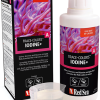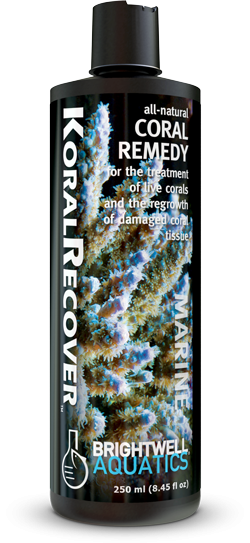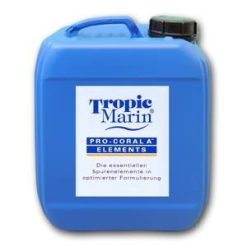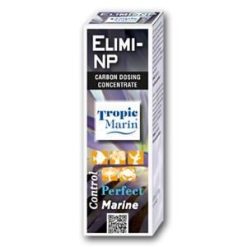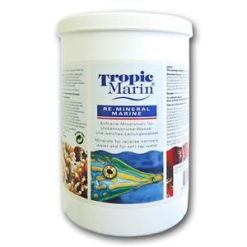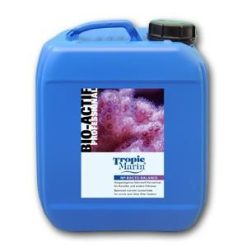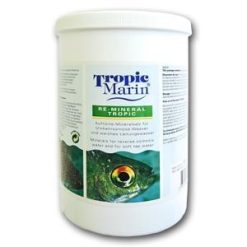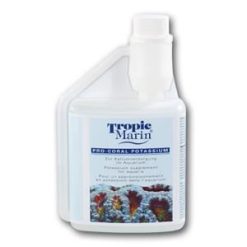KoralRecover – eliminates coral necrosis…
All-natural coral remedy for the treatment of live corals and the regrowth of damaged coral tissue

Overview
- All-Natural, herbal treatment for symptoms affecting live hard and soft corals in marine aquariums
- Treats a number of symptoms of coral disease such as RTN (Rapid Tissue Necrosis), STN (Slow Tissue Necrosis), White Band, Black Band, Brown Jelly and White Paste
- Boosts coral immune functions and increases resistance
- Stimulates regrowth of lost coral tissue that occurs due to disease, fragging and/or stress
- Safe for all coral varieties, clams, anemones, sponges, invertebrates (including shrimp), & fish (including sharks, rays, gobies, seahorses, and eels). Also safe for calcareous and macroalgae
- Will not adversely affect the biological filter as seen with antibiotic usage
- Does not discolor the aquarium water or alter water parameters.
Sizes…
125ml | 250ml | 500ml
Technical Background
Caution: Prior to fragging, research the proper fragmentation procedures for the specific coral specimens to be cut, to insure optimal success and overall safety. Wear eye goggles, and rubber gloves because some marine invertebrates can squirt toxic bodily fluids into your face when cut. The fragmentation of corals has become a common practice within the hobby of marine reef keeping.
Fragging, as it is commonly called, is simply cutting off a small portion of a parent coral colony and creating additional specimens – frags. This practice allows reef hobbyists to attain desirable coral specimens at a fraction of the cost or to share with other hobbyists while reducing impact on natural reef systems. Fragmenting corals is generally a safe process for the corals but still creates some level of stress on both the parent colony and the newly fragmented piece.
The exposed areas, at the cutting site, are more susceptible to infections and overall stress. Regrowth of coral tissue over the newly exposed area is key to the coral frag recovery. Brightwell Aquatics FragRecover will support the recovery process by aiding in the regrowth of tissue over the exposed, cut areas on both the parent colony and the frag. This will also limit exposure to infection and/or infestation by coral predators and make the fragging process more successful.
Instructions & Guidelines
Shake product well before using.
To prepare the coral frag dip solution, add 20 mL (4 capfuls ) of Frag Recover to 1/2 gallon (1.9 L) of aquarium water.
Stir solution to evenly disperse product. After the selected coral has been cut, place the fragged piece along with the parent colony into the prepared FragRecover frag dip solution for 3 minutes.
It is recommended that the solution be gently forced over the cut areas by squirting prepared solution with a turkey baster over the targeted areas. After the dip has completed, place the parent colony back into the aquarium. The new coral frag should now be glued or bonded to a solid surface to maximize grow out potential and prevent turning over. Attach the new coral frag to Brightwell Aquatics HexiDiscs (ideal surface area for frag growth) using a reef-safe glue or epoxy as directed. The new coral frag can now be added to the grow-out system (assuming like conditions of the main aquarium) or the main aquarium itself.
It will be common for both parent colony and the new coral frag to exhibit diminished polyp extension until they are re-adjusted to the aquarium. You may also consider the use of Brightwell Aquatics Medicoral prior to using FragRecover to further ease the corals transition. In this case, dip the coral in Medicoral as directed, then gently rinse the coral in aquarium water and discard the rinse. Then proceed with using FragRecover as directed.
Medicoral will gently oxidize (clean) the exposed coral tissue and further aid in coral healing. To prevent an outbreak of coral disease in the aquarium after fragmentation or treat any visibile coral infections in the aquarium, use Brightwell Aquatics Koral Recover directly in the aquarium as directed.
Caution: Keep out of reach of children. Not for human consumption. If ingested, contact a poison control center. Not for use on fish or invertebrates for human consumption!
